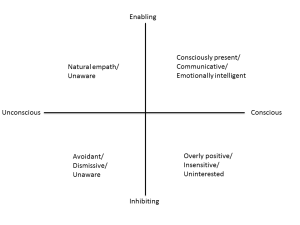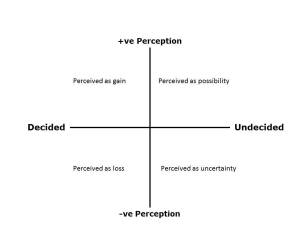In a volatile, uncertain, complex and ambiguous world (VUCA) it’s no longer enough to help people become change ready. Adapt and thrive is the new normal in today’s business environment.
What can you do to help employees adapt and thrive?
Enter the new age of the change savvy organization
Helping employees adapt to change is part of the role of change managers and leaders. Many leaders of change assume that applying a sound change methodology guarantees success. However, even with short-term improvement projects it pays to understand how you’ll create a change mindset. A change mindset is about choice; choosing what you say, feel and do about the changes. This is the new age of the change savvy employee
What can change leaders do to help create this new breed of employee?
Here I share two tools that provide the catalyst for discussing change and creating a process for change, or more accurately, transformation. The first tool unpicks the reality of the change and answers the first principle of personal change: choice and control. I talk you through how you might use this tool as a prelude to working with one of my other favourites – Stephen Covey’s circles of influence.
I have followed the format we use in our book, 50 Top Tools for Coaching, so that you have a logical flow
What is it?
As part of an incremental or transformational change activity – be it project or programme – it is usual for the ‘change team’ to have been intimately involved in the change process. During this time they will have gone through a process of awareness, understanding and adoption. During this process underlying beliefs, assumptions, values and feelings will naturally emerge. There will be a collective shared view about the change.
Often when looking to make changes in an organization the team making the changes don’t understand why people don’t ‘get it’! They discount the internal processing they personally will have experienced during this phase and as they roll the drums and shout ‘ta daa’ expect employees to immediately grasp what has taken them months to grapple with.
This tool allows those people affected by the change an opportunity to reflect on what the change might and could mean for them. It is an opportunity to start the transition process and the ongoing process of acknowledging, assessing and coming to terms with the changes.
What is it for?
It is really useful to ask people to work in groups but it can work equally well with individuals either affected or impacted by the change. It is designed to surface all the underlying perceptions about the changes that will occur using a classic 2×2 matrix. The horizontal axis is the degree to which you’ve already made a decision about the change and the vertical axis is the perception you have of the change, either positive or negative.
When do you use it?
Ideally as soon as you’re able to talk about the potential changes that the particular project or programme might create.
What is the process?
- Before working with any tool either individually or in groups it is important to contract how you will work together. For example, what ground rules there are for working together, particularly around differences of opinion. What the boundaries are about what’s up for discussion. Only proceed when everyone is clear about why they’re there, how you’ll work together and what you expect will be the outcome. For example, you might want to contain the scope of the discussion to a specific change.
- Start with a topic to get people in the flow. For example, winning the lottery. Take them through the process with this topic first and then apply the same process to the change scope you’ve established at step 1.
- Ask them to work in small groups and populate the 2X2 Matrix working through all the scenarios. For example:
- If you have decided how you view the change and see this as a positive brainstorm all the things that you might gain.
- If you have decided how you view the change and saw this as a negative brainstorm what you might lose.
- If you were undecided how you view the change and saw this as an opportunity brainstorm the possibilities that might open up.
- If you were were undecided how you view the change and saw this as a negative brainstorm what things you would be uncertain about.
- Give the groups about 10-15 minutes for this activity – it is likely that they will be able to talk for longer. Use your judgement here.
- Bring the groups back together and ask them open questions about what came up in discussions and pose the question – what would happen over time?
Hints and tips
The value of this tool is the discussion it inspires. At step 5 this is where your art as the faciliatator comes into its own. There are no right or wrong answers. This is about tapping into the values, beliefs and feelings that people have about the changes that will occur.
I mentioned the Circles of Influence tool and this is a great tool to use to help people understand how much control they actually do have over any changes that happen in the workplace. I usually start with an example about the econonmy – we might perceive we have little influence about what happens. However, we can control our own econonmy i.e. budget, so focus on that.
In this way, you are supporting people through the human aspect of change. How we perceive something is up to us and what we do about the change is also up to us. We can make that a positive or a negative; whatever we choose, make it a choice not something that is imposed by someone else.
Get out of their way!
The second tool can be used as a feedback mechanism to gauge the environment and context of the change. We are often unaware of how our own behaviour is both affected by and affects others who are also experiencing the change. Working with groups this tool is a great way of hearing about their experiences and acts as a springboard to help them reflect on their own behaviours during change.

Behavioural Awareness. Adapted from a tool created by The Corporate and Executive Coaching Organisation, 2005
What is it?
This tool is primarily designed to elicit feedback about what behaviours are helping or hindering the change. It was originally sourced from The Corporate and Executive Coaching Organisation. I have adapated the labels and the process here to act as a complementary tool to the Supporting Transitions tool above.
It is also a 2×2 matrix and plots behaviour on the horizontal axis as either intentional or unintentional. Along the vertical axis it plots the behaviour as helpful or hindering.
What is it for?
This tool can be used with leaders and managers of change to help them reflect on their own behaviours and act as a baseline for measuring their perception against their employees’. Once you’ve established the baseline perception of managers and leaders you can run the same process with groups affected by the change and compare and contrast.
When do you use it?
During the initial phases of a change project or programme. It is useful to take a sense check of where your leaders and managers think they are in the way that they support and help employees cope with change.
During the implementation phase this tool can serve well as a focus group tool to help understand how your behaviours as leaders and managers are effecting or stifling change. This tool is not for the faint hearted and requires skilful facilitation and pre-framing to work well. Most of all, it requires action. If you become aware that behaviours are hindering performance then do something about it.
On the other hand if you find out that you’re doing things that unintentionally are helpful – do more of them!!
What is the process?
- The first step is the same for any tool that you work with. Always contract how you will work together. For example, what ground rules there are for working together, particularly around differences of opinion. What the boundaries are about what’s up for discussion. Only proceed when everyone is clear about why they’re there, how you’ll work together and what you expect will be the outcome. For example, you might want to contain the scope of the discussion to a specific change.
- This tool lends itself to personal reflection first. Use a blank 2×2 model with only the labels on the axes showing i.e. take out the commentary in the boxes in the model above. Ask the group of leaders and managers to reflect on their own experiences of being managed and lead either working individually or in groups and to jot down their thoughts in the relevant quadrant. This gets them in the flow process and ready to answer specifically what is happening in the current change context.
- Ask them to reflect on what specific behaviours they are currently demonstrating on sticky notes. Get them to jot down one behaviour per post it and ask them to put the sticky note in the quadrant that best describes their behaviours.
- Faciliate a discussion about where the sticky notes have been placed and challenge their thinking about any that are either missing or could be moved to a different quadrant.
- The final step is to ask them to return to their personal experiences of being lead through change and ask them to identify if there are any gaps/opportunities for making the current change context even more supportive for employees.
- Agree how they will action the ideas from the session.
Hints and tips
Like most things, the value of this tool comes from the discussions it sparks. Make sure your contracting process is thorough at the beginning of the session and make sure you bring awareness to the group of when they might be stretching boundaries or going off the agreed ground rules.
Awareness is the first step to change so provide an opportunity for the group to go away, reflect, act and then reconvene a few weeks later to bring fresh learning back into the group and inform the change process towards transition.
How do you manage change?
As a change agent you doubtless have many examples from your own experiences that could help others. Share what keeps you awake at night in relation to managing change and help me ensure that what I offer helps you and others like you. Go to my short survey and let me hear about your experiences.
Remember, I only share the tools included in this update with members of the Change Agents Forum.
Change is always about choice – even in an uncertain world!
©Ro Gorell 2015 All Rights Reserved


Recent Comments